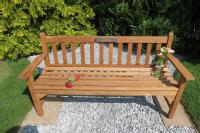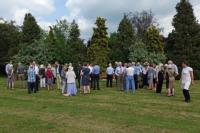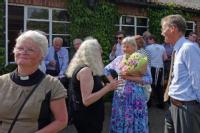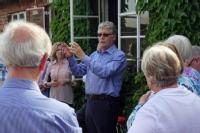Dr Jim Brewster
Jim worked as a research scientist at NVRS from 1974 to 1990. He was a world expert on onions and was the author of the highly-regarded book 'Onions and Other Vegetable Alliums’.
Obituary - Jim Brewster BSc MPhil, MIHort – 8th April 1944 – 24th October 2015
Jim was born in Bradford on 8th April 1944 and attended primary school in Beckenham, Kent. At the age of 11 he went to Dulwich College, where he obtained 9 GCE O-levels and studied for A-levels in Mathematics for Science, Biology, Physics and Chemistry, which he obtained in the summer of 1962. Jim’s interest in plant science began whilst he was at school, and at the age of 14 he started growing vegetables as a hobby.
In 1962 Jim undertook a year’s practical work on a Yorkshire farm which was a mixed livestock and arable enterprise. According to his friend, Mike Jackson, Jim was “at his amusing best describing the dreadful conditions he encountered there, his pastiche Yorkshire accent suitably amplifying the cold, the rain, the muck and inhospitality he found in God’s own county”. In 1963, Jim went to Wye College, University of London to study Agriculture, which is where he met Mike. In 1964 he switched his course from agriculture to a new honours degree option in crop science and was awarded a BSc (Hons) in Agricultural Science (Crop Science option) in 1966. Plant physiology was a major subject in this degree and applied aspects were stressed. During his time at Wye College Jim wrote an essay on the flowering physiology of onions in relation to day-length and temperature.
Jim moved to St John’s College, Oxford in 1966 and was awarded a DPhil in 1971. He then undertook post-doctoral research in the Department of Agricultural Sciences at Oxford until 1974. The main theme of Jim’s research was to combine knowledge of the growth physiology and nutrient uptake physiology of plants with knowledge of nutrient levels and mobility in soil, in order to improve understanding of the growth response of crops to soil nutrient levels. He worked with Peter Nye FRS and Professor Bernard Tinker OBE and the work culminated in a study of growth and phosphorus nutrition of onion and fodder rape, which led to several publications.
Jim’s position at Oxford was a fixed-term contract and at its end Jim was appointed to a position as a plant physiologist at the National Vegetable Research Station (NVRS), Wellesbourne, Warwickshire. He was interviewed by Professor John Bleasdale, then Head of the Plant Physiology Section, who reputedly said that he wanted Jim to “find out what makes an onion tick”. Jim started work in the Plant Physiology Section as a Senior Scientific Officer on 10th June 1974 which, incidentally, was NVRS’ Silver Jubilee year. Professor Bleasdale subsequently became the Director of NVRS in 1977, and the position of Head of the Plant Physiology Section was taken on by Professor Peter Salter. Jim was promoted to Principal Scientific Officer in 1983.
The Annual Reports for NVRS and subsequent organisations document Jim’s career in horticultural research where he worked mostly on environmental effects on onions but also on leeks and carrots and flowering in Brussels sprouts. This led to a series of peer reviewed research papers and several book chapters. The first paper on his research at Wellesbourne was published in the Annals of Applied Biology in 1979 and was entitled ‘The response of growth rate to temperature in seedlings of several Allium crop species’. In 1980 he published two papers with Professor Peter Salter on the effect of within-row spacing on the yield and uniformity of both spring and autumn sown onions. He also published papers with NVRS statisticians Drs Tony Barnes and Geoff Morris and a visiting scientist, Ferdous Mondal. Dr Mondal obtained his PhD working with Jim on onion shading which helped to explain the influence of red and far-red light on the onset of onion bulbing.
NVRS became part of the Institute of Horticultural Research (IHR) on 1 April 1987 when East Malling Research Station, Glasshouse Crops Research Institute, NVRS and the Hops Research Department at Wye College merged. Jim became a member of the Crop Production division and during this time he published papers with Heather Butler (now Heather Clay) who had worked as his assistant for some time. On 4th May 1990 Horticulture Research International (HRI) was formed though the merger of IHR and the ADAS Experimental Horticulture Stations (EHS).
During 1990, Jim was author or co-author of 8 publications, several of these with Professor Haim Rabinowitch (Professor Emeritus at the Robert H. Smith Institute of Plant Sciences and Genetics in Agriculture at The Hebrew University of Jerusalem) with whom he co-edited the major three volume work ‘Onions and Allied Crops’ (Volume I Botany, Physiology, and Genetics; Volume II. Agronomy, Biotic Interactions, Pathology, and Crop Protection; Volume III. Biochemistry, Food Science, and Minor Crops).
Jim made many friends over his working life. Jim’s friendship with Haim Rabinowitch began in the early 1970s. The International Agricultural Centre (IAC) in Wageningen provided a variety of long and short courses for students from developing countries as well as accommodation and some cultural activity. Dr Suren Apte was leader of the vegetable course. He invited Haim to lecture on vegetable production in tropical and subtropical regions. This was an intensive week where Haim was supposed to cover quite a broad variety of cropping systems and important crops. However, Haim decided to focus on two economically important crops: tomato and onion, two extremes with regard to response to environment. Also, Haim could demonstrate production in open fields in comparison to indoors (light structures, not Dutch greenhouses). After the first year (1976), Haim decided “that it was much too heavy on my vocal cords (8 hrs/day) and felt that I needed someone to share the burden. Jim was the obvious choice. I knew about him and met him in person in Wellesbourne in summer 1975, and knew that we could make a good complementary team. We did. For the next 28 consecutive years (with very few exceptions) we delivered the course, quite successfully”. To quote Haim further, “there was an excellent complementation and the classes learned to appreciate the orchestrated music we played, enjoying the concert of the science of alliums. In the evenings, after six o'clock dinner, we used to take a walk in the narrow streets of Wageningen, drink some beers together, cold beer it was, and enjoyed the excellent ice-cream offered by this little ice-cream shop that Jim appreciated a lot; and we talked. Then, it wasn't necessarily classes or science. It was everything else”. They stopped teaching in Wageningen when Haim was elected rector of the Hebrew University of Jerusalem and had no more "free" time for such endeavours.
Jim’s ‘pièce de résistance’, was his book ‘Onions and Other Vegetable Alliums’ first published in 1994 with an updated second edition in 2008. This book relates the production and utilization of Allium crops to many aspects of plant science underpinning their production and storage technologies. It covers species and crop types, plant structure, genetics and breeding, physiology of growth and development as well as pests and diseases, production agronomy, storage after harvest and the biochemistry of flavour, storage carbohydrates and colour and how this relates to nutritional and health benefits. It provides many examples where scientific knowledge help to illuminate, explain and improve agronomic practice. This book is still the standard reference work for many people; and although aimed at the more popular and applied end of the research spectrum, it is, to quote Brian Smith, previously a colleague of Jim’s at NVRS and another Allium expert: “The first book reached down from the bookshelf when information is needed or some knotty problem rears its head”.
Jim took early retirement from HRI in 1990 but maintained a great interest in onions after his retirement and he continued to publish and attend conferences, often accompanied by his wife, Marnie. His publications were influential and earned Jim a significant international reputation within the Allium research community. Consequently, he was made welcome at numerous meetings around the world. In particular his research work on bulb development and vernalisation was vital in improving understanding of ‘how an onion ticks’. Jim also developed an interest in competitive onion growing and in 2012 presented and co-authored a paper on ‘Growing large onions for exhibition and competition in the UK’ at the 6th International Symposium on Edible Alliaceae in Fukuoka, Japan (Acta Horticulturae, Volume: 969, 153-162).
Although Jim is usually thought of as an onion physiologist, his passion for knowledge extended into the genetics and breeding of the onion crops. The two leading onion geneticists are John McCallum in New Zealand and Mike Havey in the USA. John has written “Jim was a great inspiration and support to the few of us working on onions. It is a measure of the standards he and his colleagues set that it has been difficult to greatly extend this work. His text of ‘Onions and Other Vegetable Alliums’ is still the ‘go to’ text for old and new hands. Mike wrote “Jim was a stalwart of the Allium research community, and his papers, books, and reviews especially regarding bulbing and flowering will always be considered as classics. Whenever I contacted or visited with him, I always found Jim to be readily accepting of questions and provided deeply thoughtful answers.”
Jim attended almost all the international Symposiums related to Edible Allium organized by the ISHS (International Society for Horticultural Science). He was a Keynote speaker in most of them. To quote Claudio Galmarini, chair of the Edible Allium working group “Jim was always a reference for the Allium community around the World. I always remember his generosity accepting to attend the First Symposium that we hosted at Mendoza in 1994, a meeting that in many ways would change his personal life. His contribution to onion physiology is fundamental to understand onion growth and development. His text of ‘Onions and Other Vegetable Alliums’ have been translated to many languages and is consulted worldwide. He was very generous as a scientist and human being.”
In 1999, Jim and Lesley Currah (another colleague from NVRS days) took a trip to Venezuela at the invitation of a local onion growers' organization and of their friend and colleague Dr Hugo Ramirez, who wanted to promote better understanding of how the onion grows and what controls growth (Jim's field of expertise) and also to hear about which onions are grown in other parts of the tropics and how they are produced and stored (Lesley’s area of expertise). The growing area was the Quibor depression west of Caracas and near the city of Barquisimeto, where Hugo worked at the University. Some of the course members were farmers and many were extension and research workers, and the visitors got a very warm reception from them. With the help of an interpreter Jim made good use of the Wageningen onion teaching materials. To quote Lesley “I will always remember how nice it was to travel with a companion like Jim, and to be able to share ideas and reflections with him. Of course I also learned a lot by listening to him putting over his share of the topics to our students, and his thorough approach increased my already great respect for him as a scientist. He had a huge enthusiasm for plant science: I also remember that we had a lot of fun going round the Caracas Botanical Garden and admiring the numerous different types of palm trees in a spectacular collection there. An example of Jim’s generosity was his gift to me of a complete set of his Venezuelan onion slides, made after we returned to UK”.
Through his research and his interactions with academics, students and those working in the industry Jim had a considerable impact on crop and plant science. To quote his forward to the second edition of ‘Onions and Other Vegetable Alliums’ “I hope that this book may serve not just as a source of some rather specialist information on the production of alliums; but can chart a path through the disciplines of plant science and show how they connect and interrelate when it comes to the application of crop technology.” Obviously onions and other edible Alliaceae was Jim’s ‘specialist subject’ and his contribution can be summed up by the following two quotes, firstly from Lesley Currah: “His publications are landmarks in onion science. It is great that today's students are able to take the topic forward in terms of the genetics of day-length control in onions and other plants. We can regret his loss but know that progress is still going on in the topics about which he spent many years investigating and educating people” and his friend Steve McArthur, a plant breeder from New Zealand: “Jim is a legend in the onion world and he will be sorely missed by everyone in the onion growing community around the world. So many people owe so much of their success, to the insights that Jim gave through his research and extension work.







